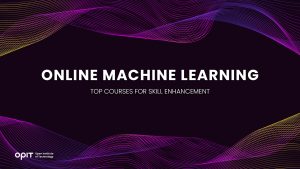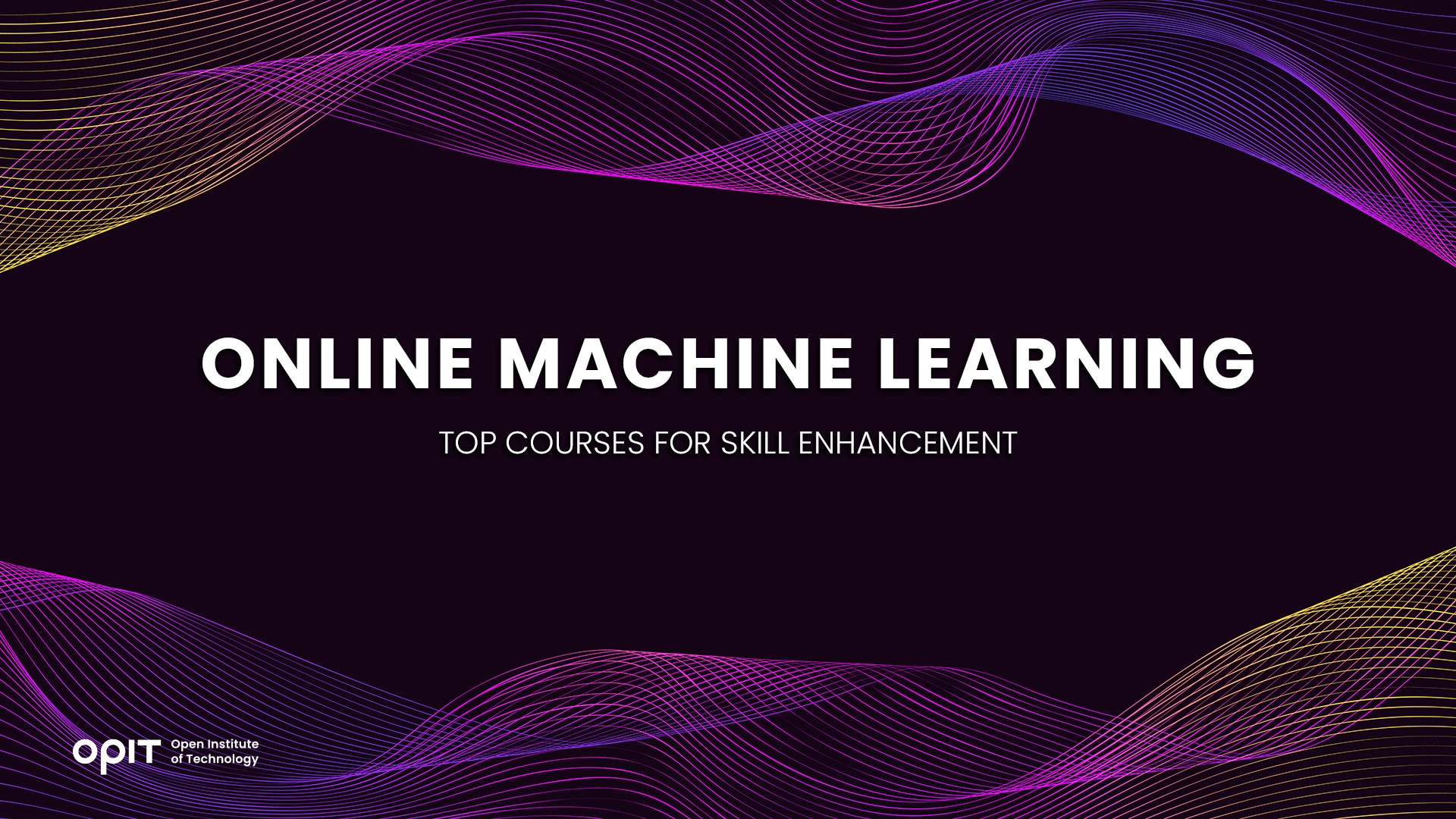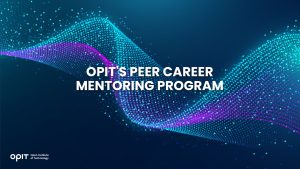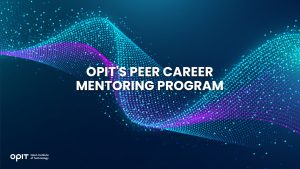

Once a concept found exclusively in science fiction, machine learning has seen widespread use in the modern age. As soon as various industries grasped the potential of ML, this field of computer science turned into a staple of tech and other businesses.
Naturally, all this has led to an increased demand for machine learning experts. The job market abounds with offers for positions in the field, and the competition is fierce. In other words, you may find plenty of job openings for machine learning professionals, but you’ll need to fit the bill to actually land the position.
Fortunately, there are plenty of online machine learning courses to give you the needed expertise and boost your skills. This article will help you find the best machine learning course online and explain the top options in detail.
Factors to Consider When Choosing an Online Machine Learning Course
If you like the idea of online learning, machine learning courses are readily available. In fact, the number of options may be overwhelming. That’s why we’ve applied certain strict criteria when looking for the best machine learning online course. Moving forward, you should also keep those criteria in mind.
Firstly, the content of the course will matter the most. Machine learning is a broad field, and you’ll want to ensure that the education you’re getting is the one you need. Also, every genuine venue of machine learning online training should give you a solid foundation while placing a particular emphasis to specific skills.
The curriculum won’t be the only aspect of the course that matters, though. Who is teaching you will be crucial as well. Ideally, your instructor should be an experienced professional in the field so that they can teach you the theory as well as the practical applications.
Next, one of the primary reasons why you’d want to take a course rather than enroll into a BSc or MSc program is time. You don’t want a course to take up too much of your time, which is why flexibility and the overall duration are essential. You’ll want a well-structured online machine learning course that will leave room for a job or any other activities.
Beside the knowledge provided, hands-on experience will be vital. Once you complete a course, you should be able to apply everything you’ve learned there. To that end, a quality machine learning online course will focus heavily on the real-world application of the skills taught.
Finally, the pricing will play a major role. Similar to time, budgetary concerns are likely a core reason why you’re opting for a course. Simply put, you don’t want it to cost the same as a year at a university. And if the price is somewhat higher, the course should provide plenty of additional resources to justify it.
Top Online Machine Learning Courses
Imperial College Business School – Professional Certificate in Machine Learning and Artificial Intelligence
Course Overview
This program deals with the essential AI and machine learning concepts, teaching you when and how ML solutions can be applied to real-life problems. The course is relatively long, lasting for 25 weeks. It was developed in collaboration with the Imperial College’s Department of Computing.
Key Features
- Taught by experts
- Hands-on activities
- Projects worthy of your portfolio
- Ends with a capstone project
- Verified digital certificate
Pricing and Additional Resources
The price of this course is £3,995, which is reasonable considering its extended duration. During the course, you’ll have individual advisor support for career-building. Completing your studies will also grant you the status of an Associate Alumni, allowing you to join the Imperial College Business School’s community.
Google Digital Garage – Machine Learning Crash Course
Course Overview
If you want to learn machine learning fundamentals quickly and efficiently, this course is just the ticket. It includes comprehensive text and video lectures, practical exercises, and work with the TensorFlow ML library. You’ll gain relevant knowledge and experience through three modules lasting a total of 15 hours.
Key Features
- Lecturers are Google’s researchers
- Intermediate level
- Genuine case studies
- Interactive algorithm showcases
- Fast-paced and applicable
Pricing and Additional Resources
If you’re wondering how much a course from a leading tech giant company may cost, you’ll be pleasantly surprised: This Google machine learning online course is absolutely free. In addition, it’s quite short and very efficient.
IBM (via edX) – Machine Learning With Python: A Practical Introduction
Course Overview
This course teaches you supervised and unsupervised machine learning using Python. An introductory course, it may last up to five weeks. Best of all, the program is entirely self-paced, meaning you can tackle individual lessons at a tempo that suits you. It’s worth noting that this course also explores widely used models and algorithms, supported by actual examples.
Key Features
- Taught by a Senior Data Scientists at IBM
- Part of IBM’s one year certificate program for data science professionals
- Beginner-friendly
- Focus on statistics and data analysis
Pricing and Additional Resources
Like Google’s course, this program by IBM, hosted on edX, is free. It’s worth noting that there’s also a “Verified Track” version, priced on edX at $99. This version of the course will provide unlimited source material access, exams, graded assignments, and a shareable certificate.
DeepLearning.AI (via Coursera) – Unsupervised Learning, Recommenders, Reinforcement Learning
Course Overview
As a part of a specialization in machine learning, this course teaches unsupervised learning as a particular branch of ML. You’ll also learn about recommender systems and how to build certain machine learning models. The course is designed by experienced DeepLearning.AI members in collaboration with Stanford University. You’ll be able to complete it in about 27 hours.
Key Features
- Flexible course scheduling
- Part of a three-course specialization
- Taught by an experienced lecturer and ML professional
- Beginner-friendly
- Teaches specific machine learning techniques
Pricing and Additional Resources
This course, as well as the entire specialization, is available with a Coursera subscription. As a subscriber, you won’t pay any additional fees for the course. Plus, you’ll gain access to a shareable certificate, practice and graded quizzes, and other subscriber benefits.
Microsoft – Foundations of Data Science for Machine Learning
Course Overview
More than a regular course, Foundations of Data Science for Machine Learning is a learning path which consists of 14 modules. It will take you through the entire journey, from the machine learning basics to advanced architecture and data analysis. The course can be completed in under 13 hours.
Key Features
- Offered by a leading tech giant
- Provides lessons and exercises
- Entirely browser-based
- Interactive learning
Pricing and Additional Resources
This training course by Microsoft is free and available immediately. Enrolling in the course comes with no prerequisites.
Tips for Success in Online Machine Learning Courses
Once you choose a machine learning online course, simply signing up for it won’t be enough. You’ll want to ensure you’re getting the most value out of the program. To that end, it would be best to apply the following tips:
- Set your goals and expectations: The best way to get optimal results from a course is to go into it knowing precisely what you want. Clarify what you’re looking to achieve and what you expect the course to provide, and you’ll have an easier time both choosing and completing the program.
- Dedicate time to study and practice: Course lectures will be a vital part of the learning process, but the time and work you put into it will be what makes it all worthwhile. Approach your machine learning online course with the utmost dedication and responsibility, making sure to always set aside the time of day for studying.
- Engage with the community: A learning environment is perfect for building a network. You’ll contact other people with similar interests, which may broaden your viewpoint, provide additional knowledge, and even open up job opportunities. Don’t shy away from online forums or any other type of meeting place that your peers frequent.
- Try out new skills and concepts in real-life: Even if the course you pick involves practical projects, you should be proactive beyond that point. Take what you’ve learned and try to apply it on something outside the course. The best time to start practicing is as soon as you learn a new skill.
- Keep updating your knowledge and skills: Machine learning progresses rapidly, so you’ll have to do your best in keeping your knowledge and skills relevant. A quality course will give you a good foundation. However, updating what you’ve learned will be entirely up to you.
Become a Machine Learning Expert Online
If you’ve found the best machine learning course online for your purposes, you should start learning right away. Armed with the proper skills, you’ll have greater chances of getting work in the industry and starting a career in this science of the future.
Explore which machine learning online course fits you best and start pursuing your goals. You’ll find the knowledge and experience gained as the perfect catalysts for personal and professional growth.
Related posts

Source:
- Raconteur, published on November 06th, 2025
Many firms have conducted successful Artificial Intelligence (AI) pilot projects, but scaling them across departments and workflows remains a challenge. Inference costs, data silos, talent gaps and poor alignment with business strategy are just some of the issues that leave organisations trapped in pilot purgatory. This inability to scale successful experiments means AI’s potential for improving enterprise efficiency, decision-making and innovation isn’t fully realised. So what’s the solution?
Although it’s not a magic bullet, an AI operating model is really the foundation for scaling pilot projects up to enterprise-wide deployments. Essentially it’s a structured framework that defines how the organisation develops, deploys and governs AI. By bringing together infrastructure, data, people, and governance in a flexible and secure way, it ensures that AI delivers value at scale while remaining ethical and compliant.
“A successful AI proof-of-concept is like building a single race car that can go fast,” says Professor Yu Xiong, chair of business analytics at the UK-based Surrey Business School. “An efficient AI technology operations model, however, is the entire system – the processes, tools, and team structures – for continuously manufacturing, maintaining, and safely operating an entire fleet of cars.”
But while the importance of this framework is clear, how should enterprises establish and embed it?
“It begins with a clear strategy that defines objectives, desired outcomes, and measurable success criteria, such as model performance, bias detection, and regulatory compliance metrics,” says Professor Azadeh Haratiannezhadi, co-founder of generative AI company Taktify and professor of generative AI in cybersecurity at OPIT – the Open Institute of Technology.
Platforms, tools and MLOps pipelines that enable models to be deployed, monitored and scaled in a safe and efficient way are also essential in practical terms.
“Tools and infrastructure must also be selected with transparency, cost, and governance in mind,” says Efrain Ruh, continental chief technology officer for Europe at Digitate. “Crucially, organisations need to continuously monitor the evolving AI landscape and adapt their models to new capabilities and market offerings.”
An open approach
The most effective AI operating models are also founded on openness, interoperability and modularity. Open source platforms and tools provide greater control over data, deployment environments and costs, for example. These characteristics can help enterprises to avoid vendor lock-in, successfully align AI to business culture and values, and embed it safely into cross-department workflows.
“Modularity and platformisation…avoids building isolated ‘silos’ for each project,” explains professor Xiong. “Instead, it provides a shared, reusable ‘AI platform’ that integrates toolchains for data preparation, model training, deployment, monitoring, and retraining. This drastically improves efficiency and reduces the cost of redundant work.”
A strong data strategy is equally vital for ensuring high-quality performance and reducing bias. Ideally, the AI operating model should be cloud and LLM agnostic too.
“This allows organisations to coordinate and orchestrate AI agents from various sources, whether that’s internal or 3rd party,” says Babak Hodjat, global chief technology officer of AI at Cognizant. “The interoperability also means businesses can adopt an agile iterative process for AI projects that is guided by measuring efficiency, productivity, and quality gains, while guaranteeing trust and safety are built into all elements of design and implementation.”
A robust AI operating model should feature clear objectives for compliance, security and data privacy, as well as accountability structures. Richard Corbridge, chief information officer of Segro, advises organisations to: “Start small with well-scoped pilots that solve real pain points, then bake in repeatable patterns, data contracts, test harnesses, explainability checks and rollback plans, so learning can be scaled without multiplying risk. If you don’t codify how models are approved, deployed, monitored and retired, you won’t get past pilot purgatory.”
Of course, technology alone can’t drive successful AI adoption at scale: the right skills and culture are also essential for embedding AI across the enterprise.
“Multidisciplinary teams that combine technical expertise in AI, security, and governance with deep business knowledge create a foundation for sustainable adoption,” says Professor Haratiannezhadi. “Ongoing training ensures staff acquire advanced AI skills while understanding associated risks and responsibilities.”
Ultimately, an AI operating model is the playbook that enables an enterprise to use AI responsibly and effectively at scale. By drawing together governance, technological infrastructure, cultural change and open collaboration, it supports the shift from isolated experiments to the kind of sustainable AI capability that can drive competitive advantage.
In other words, it’s the foundation for turning ambition into reality, and finally escaping pilot purgatory for good.

The Open Institute of Technology (OPIT) is the perfect place for those looking to master the core skills and gain the fundamental knowledge they need to enter the exciting and dynamic environment of the tech industry. While OPIT’s various degrees and courses unlock the doors to numerous careers, students may not know exactly which line of work they wish to enter, or how, exactly, to take the next steps.
That’s why, as well as providing exceptional online education in fields like Responsible AI, Computer Science, and Digital Business, OPIT also offers an array of career-related services, like the Peer Career Mentoring Program. Designed to provide the expert advice and support students need, this program helps students and alumni gain inspiration and insight to map out their future careers.
Introducing the OPIT Peer Career Mentoring Program
As the name implies, OPIT’s Peer Career Mentoring Program is about connecting students and alumni with experienced peers to provide insights, guidance, and mentorship and support their next steps on both a personal and professional level.
It provides a highly supportive and empowering space in which current and former learners can receive career-related advice and guidance, harnessing the rich and varied experiences of the OPIT community to accelerate growth and development.
Meet the Mentors
Plenty of experienced, expert mentors have already signed up to play their part in the Peer Career Mentoring Program at OPIT. They include managers, analysts, researchers, and more, all ready and eager to share the benefits of their experience and their unique perspectives on the tech industry, careers in tech, and the educational experience at OPIT.
Examples include:
- Marco Lorenzi: Having graduated from the MSc in Applied Data Science and AI program at OPIT, Marco has since progressed to a role as a Prompt Engineer at RWS Group and is passionate about supporting younger learners as they take their first steps into the workforce or seek career evolution.
- Antonio Amendolagine: Antonio graduated from the OPIT MSc in Applied Data Science and AI and currently works as a Product Marketing and CRM Manager with MER MEC SpA, focusing on international B2B businesses. Like other mentors in the program, he enjoys helping students feel more confident about achieving their future aims.
- Asya Mantovani: Asya took the MSc in Responsible AI program at OPIT before taking the next steps in her career as a Software Engineer with Accenture, one of the largest IT companies in the world, and a trusted partner of the institute. With a firm belief in knowledge-sharing and mutual support, she’s eager to help students progress and succeed.
The Value of the Peer Mentoring Program
The OPIT Peer Career Mentoring Program is an invaluable source of support, inspiration, motivation, and guidance for the many students and graduates of OPIT who feel the need for a helping hand or guiding light to help them find the way or make the right decisions moving forward. It’s a program built around the sharing of wisdom, skills, and insights, designed to empower all who take part.
Every student is different. Some have very clear, fixed, and firm objectives in mind for their futures. Others may have a slightly more vague outline of where they want to go and what they want to do. Others live more in the moment, focusing purely on the here and now, but not thinking too far ahead. All of these different types of people may need guidance and support from time to time, and peer mentoring provides that.
This program is also just one of many ways in which OPIT bridges the gaps between learners around the world, creating a whole community of students and educators, linked together by their shared passions for technology and development. So, even though you may study remotely at OPIT, you never need to feel alone or isolated from your peers.
Additional Career Services Offered by OPIT
The Peer Career Mentoring Program is just one part of the larger array of career services that students enjoy at the Open Institute of Technology.
- Career Coaching and Support: Students can schedule one-to-one sessions with the institute’s experts to receive insightful feedback, flexibly customized to their exact needs and situation. They can request resume audits, hone their interview skills, and develop action plans for the future, all with the help of experienced, expert coaches.
- Resource Hub: Maybe you need help differentiating between various career paths, or seeing where your degree might take you. Or you need a bit of assistance in handling the challenges of the job-hunting process. Either way, the OPIT Resource Hub contains the in-depth guides you need to get ahead and gain practical skills to confidently move forward.
- Career Events: Regularly, OPIT hosts online career event sessions with industry experts and leaders as guest speakers about the topics that most interest today’s tech students and graduates. You can join workshops to sharpen your skills and become a better prospect in the job market, or just listen to the lessons and insights of the pros.
- Internship Opportunities: There are few better ways to begin your professional journey than an internship at a top-tier company. OPIT unlocks the doors to numerous internship roles with trusted institute partners, as well as additional professional and project opportunities where you can get hands-on work experience at a high level.
In addition to the above, OPIT also teams up with an array of leading organizations around the world, including some of the biggest names, including AWS, Accenture, and Hype. Through this network of trust, OPIT facilitates students’ steps into the world of work.
Start Your Study Journey Today
As well as the Peer Career Mentoring Program, OPIT provides numerous other exciting advantages for those who enroll, including progressive assessments, round-the-clock support, affordable rates, and a team of international professors from top universities with real-world experience in technology. In short, it’s the perfect place to push forward and get the knowledge you need to succeed.
So, if you’re eager to become a tech leader of tomorrow, learn more about OPIT today.
Have questions?
Visit our FAQ page or get in touch with us!
Write us at +39 335 576 0263
Get in touch at hello@opit.com
Talk to one of our Study Advisors
We are international
We can speak in:


